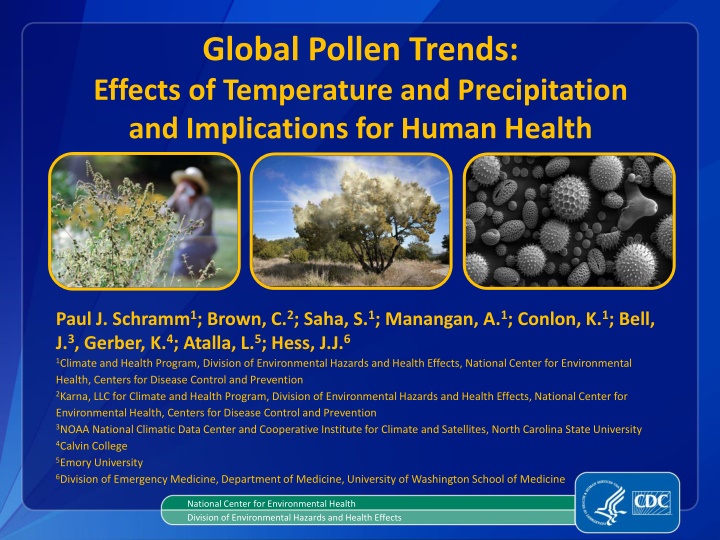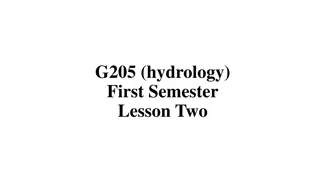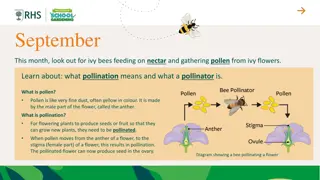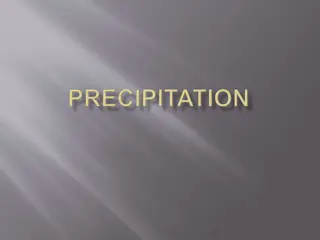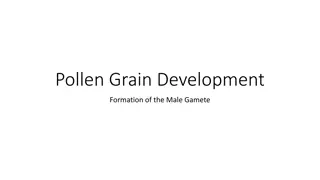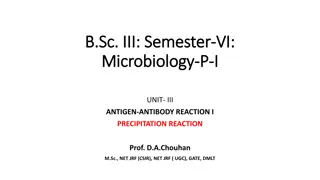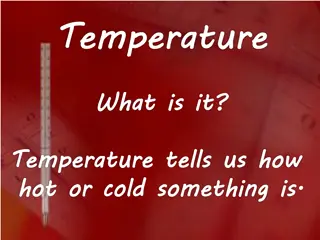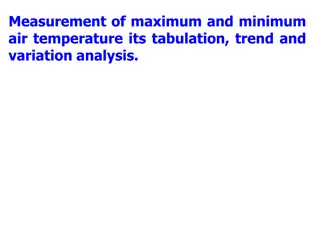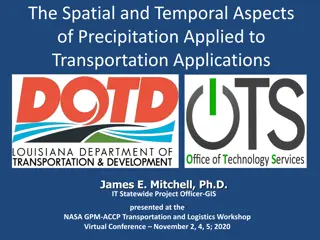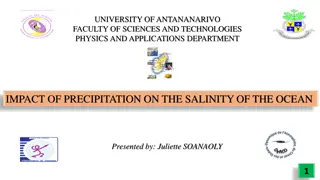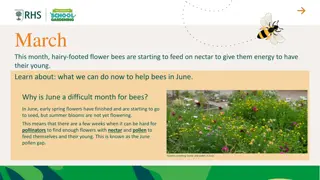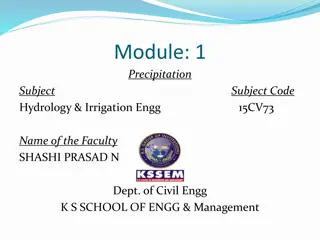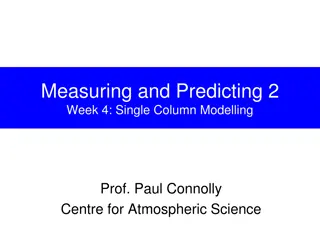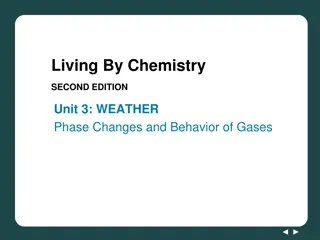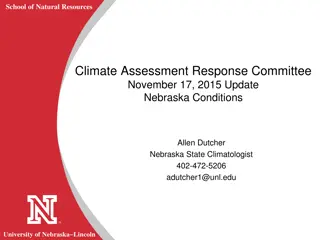Impact of Temperature and Precipitation on Global Pollen Trends and Human Health
Pollen significantly affects millions of Americans with allergic rhinitis, asthma, and respiratory issues, resulting in substantial healthcare costs. This study investigates the effects of temperature and precipitation shifts on pollen production, tracking trends over time through literature reviews and data analysis. By examining airborne pollen measurements and meteorological data, the research aims to understand how climate changes influence pollen seasonality and intensity, providing insights into potential implications for human health.
Download Presentation

Please find below an Image/Link to download the presentation.
The content on the website is provided AS IS for your information and personal use only. It may not be sold, licensed, or shared on other websites without obtaining consent from the author.If you encounter any issues during the download, it is possible that the publisher has removed the file from their server.
You are allowed to download the files provided on this website for personal or commercial use, subject to the condition that they are used lawfully. All files are the property of their respective owners.
The content on the website is provided AS IS for your information and personal use only. It may not be sold, licensed, or shared on other websites without obtaining consent from the author.
E N D
Presentation Transcript
Global Pollen Trends: Effects of Temperature and Precipitation and Implications for Human Health Paul J. Schramm1; Brown, C.2; Saha, S.1; Manangan, A.1; Conlon, K.1; Bell, J.3, Gerber, K.4; Atalla, L.5; Hess, J.J.6 1Climate and Health Program, Division of Environmental Hazards and Health Effects, National Center for Environmental Health, Centers for Disease Control and Prevention 2Karna, LLC for Climate and Health Program, Division of Environmental Hazards and Health Effects, National Center for Environmental Health, Centers for Disease Control and Prevention 3NOAA National Climatic Data Center and Cooperative Institute for Climate and Satellites, North Carolina State University 4Calvin College 5Emory University 6Division of Emergency Medicine, Department of Medicine, University of Washington School of Medicine National Center for Environmental Health Division of Environmental Hazards and Health Effects
Presenter Disclosures No relationships to disclose
Background Pollen affects health 30 60 million Americans with Allergic Rhinitis1 $11 billion per year spent on treatment2 Asthma3, chronic obstructive pulmonary disease4, and respiratory tract infections4 can be caused or exacerbated by pollen inhalation Increasing evidence of changes in pollen production Key question: How are shifts in temperature and precipitation affecting pollen production? 1Wallace et al, 2008; 2Blaiss et al, 2010; 3Cicera et al, 2012; 4Hanigan and Johnston, 2007
Methods Literature Review Peer-reviewed published research tracking pollen counts over time Through January 31, 2016 (currently updating through October 2017) Environmental Science Collection, Scopus, and CAB Abstracts databases Title or abstract contained: a pollen-related term adjacent (within three words) to a measurement/trend term a term relating to seasonality, climate, or temperature Pollen terms Measurement terms Seasonal terms Pollen, aero-allerg*, aeroallerg* Quantit*, producti*, increase*, Season*, Phenolog*, Spring, Autumn, Fall, flowering, start, peak, onset, temperature*, climate, aerobiolog*, forecast*, pattern* release*, amount*, concentration*, elevat*, measure*, detection, trend*, count*, change*, variation*, data, cubic meter*, cubic metre*, scale, level*, index, indices , grains, records
Parameters for Study Inclusion Study length: At least 5 years of measured pollen data Pollen: Airborne pollen measurements Trends: Analyze or report the presence or absence of a trend in seasonality (length, start, end, or peak pollen date) or intensity (total annual pollen, daily concentration, or peak concentration) Meteorological Data: Analyze or report relationship between pollen and locally/regionally relevant meteorological data Reporting: Quantitative pollen or trend data
8723 articles identified 307 screened in-depth 62 included
Results Number of Analyses Season start date 191 Season end date 112 Peak pollen date 73 Season length 161 Total annual pollen 1499 Mean daily pollen 35 Peak day pollen 71
Shifts in Pollen Timing (% of analyses) 70 60 62% 50 47% 45% 40 38% 30 27% 26% 26% 20 18% 10 12% 0 Start Date End Date Peak Date Earlier Later No Change
Shifts in Pollen Amount (% of analyses) 70 66% 60 60% 55% 50 40 42% 40% 30 31% 20 10 0% 3% 3% 0 Total Annual Pollen Mean Daily Pollen Peak Day Pollen Increase Decrease No Change
Oak pollen and higher temperatures 18 Number of analyses showing correlation 16 14 12 10 8 + 6 * 4 2 0 Start date Mean daily pollen Annual amount Increase Earlier No correlation *Mean Daily Pollen [Study with 14 sites reported average positive association] +Annual Pollen [Study with 97 sites reported significant positive association between mean temperature Jan-April and annual oak pollen count]
Ragweed pollen and higher temperatures 12 Number of analyses showing correlation 10 8 6 * 4 2 0 Season length Annual amount Mean daily amount Increase Decrease No correlation *Annual Pollen [Study with 97 sites reported significant positive association between mean temperature and annual ragweed pollen count]
Summary For both oak and ragweed, association between increasing temperatures and: earlier start dates greater mean daily pollen greater total annual pollen Meta-analysis is exceedingly difficult Need for consistent data; National pollen monitoring network (CSTE/CDC)
Next Steps Update with 2017 data Analysis of geographic variation Analysis of impact of precipitation Statistical analysis of impacts of temperature and precipitation on pollen production
Climate and Health Program Division of Environmental Hazards & Health Effects National Center for Environmental Health Centers for Disease Control and Prevention Email: pschramm@cdc.gov climateandhealth@cdc.gov Website: http://www.cdc.gov/climateandhealth/ For more information please contact the Centers for Disease Control and Prevention 1600 Clifton Road NE, Atlanta, GA 30333 Telephone: 1-800-CDC-INFO (232-4636)/TTY: 1-888-232-6348 E-mail: cdcinfo@cdc.gov Web: http://www.cdc.gov The findings and conclusions in this report are those of the authors and do not necessarily represent the official position of the Centers for Disease Control and Prevention. National Center for Environmental Health Division of Environmental Hazards and Health Effects
